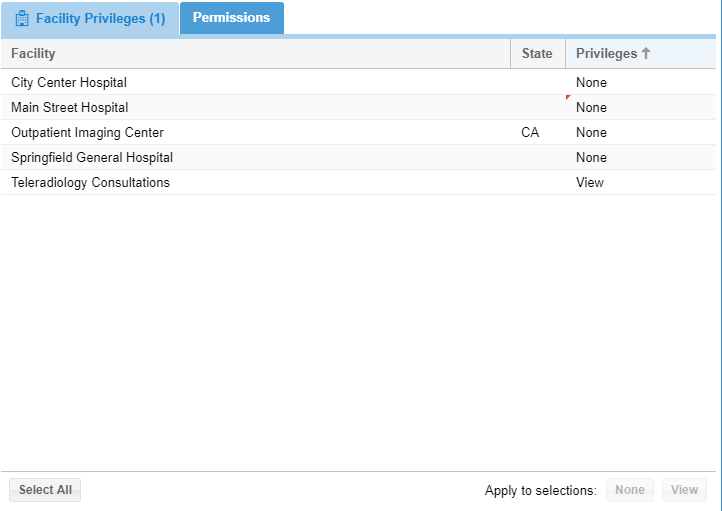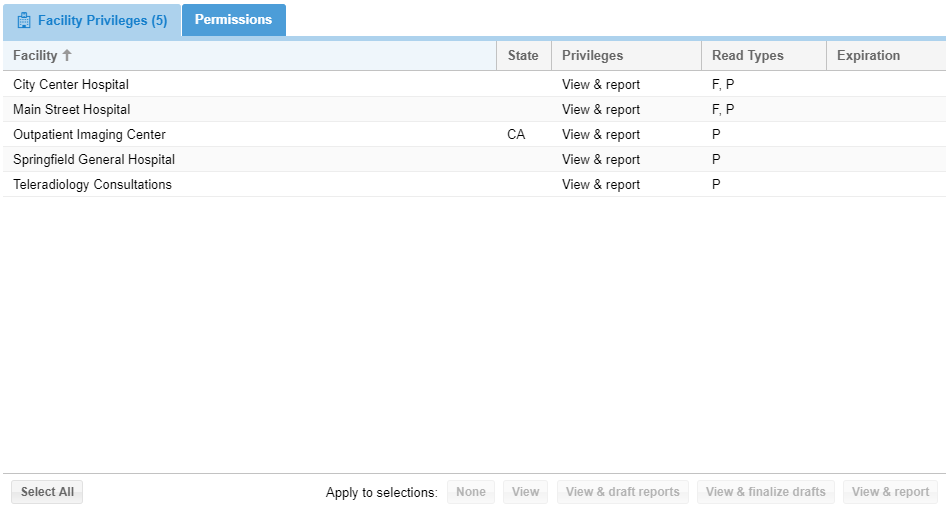Facility privileges
Facility privileges are the most basic means of restricting users' access to cases in the OnePacs system. User facility privileges can be modified by an authorized user manager by editing a user account and selecting the "Facility Privileges" tab (pictured below).
Privilege Levels
For each Facility transmitting cases to the OnePacs system, each user of the system may have one of the following types of privileges:
| Privilege | Description | |
| No privileges | The user will not be able to access cases from the facility. Exceptions: User may be granted access on a case-by-case basis by administrators, or the user may be able to view the case if the user has access to a shared folder containing the case. | |
| View only | The user will be able to see the case on a OnePacs worklist, view reports for the case, and (if the user has been giving view study permissions), the user will be able to view case images. | |
| View and save draft report | User can view the case, and also save a draft report for the case. User can not complete a primary report. (Drafting is restricted to administrators, radiologists, transcriptionists, and radiology assistants) | |
| View and report | User can view the case, and complete a primary reports for the case. User can also save a draft. (Completing a primary report is restricted to administrators and radiologists) | |
Expiration
Facility privileges of type “View and Report” may be assigned an expiration date. Once the expiration date is reached, the user’s privileges for that facility will automatically revert to “View and Draft.”
To help prevent disruptions, the system will send email reminders of upcoming privilege expirations to both:
The user’s registered email address
The designated OnePACS Radiology Groups Administrator
Reminder emails are sent 60, 30, 7, 3, 2, and 1 day(s) before the privilege expiration date.
If you would like to customize the content of these reminder emails, please contact OnePACS Support.
Read Types
For facilities which support more that one read type, radiologists may be granted privileges for all or a sub-set of the available read types. For example, a radiologist could be allowed to only enter preliminary reports at a facility that supports both preliminary and final.
Available read types include "Preliminary", "Final", "Other", and "Pre-read".
Preliminary, Final, and "Other" read types.
The first three read types (Preliminary, Final, and Other) are public read types - when reports of one of these three read types are issued, they will be visible to appropriately authorized and privileged users for the facility that sent the case, for example, ER physicians, or other referring physicians.
Pre-read read type
An additional, purely internal read type, also exists, which is called a "Pre-read". Reports that are issed of the "pre-read" type are visible only to radiology group-side users, such as radiologists, radiology support personnel, and group administrators.
The "pre-read" read type is not active in OnePACS by default. The pre-read read type can be enabled by asking OnePACS support to activate this read type.
Pre-read reports are not available to clients/sending facilities
Please note that any report of a "pre-read" read type can not be sent to report destinations, and can not be viewed by any users other than radiology group-side users. This is by design due to the intended internal use case of the pre-read read type.
Thus, it is not possible for "pre-read" reports to be transmitted to report destinations, even intentionally/manually.
For a sending facility to receive a report for a study that has received a pre-read, it will be necessary for another reader to enter a report of a read type other than "pre-read", such as a Preliminary, Final, or "Other" read type.
When the pre-read read type is active for your radiology group, it will appear as a type of read that can be activated per-facility:
When the pre-read read type is active for a facility, the read type will show in the list of privilege options for radiologists who have privileges at the facility:
When a reader has entered a pre-read report for a study, radiology group-side users (radiologists, radiology support, and administrators), will see the case on the OnePACS worklist as follows:
The clipboard icon indicates the presence of a pre-read, which can be previewed by hovering over the report icon.
However, the appearance of the case on the worklist will be no different from any other unread case when viewed by referring facility-side users (referring physicians, sending facility technologists, sending facility user managers, and so on):
Note: Though cases with pre-reads will appear the same as other cases without sending facility-facing reports, during the period of time when the pre-read case is locked by a reader, the study will display on the worklist as "locked" by the pre-reader to facility-side users.
Multiple read types
Through the re-assignment capabilities of auto-assignment rules, as needed, studies can be configured to pass through a sequential cascade of drafts and/or pre-reads, preliminary reads, and final reads. See "Multiple Read Types" for further details.
| Read type | Description |
|---|---|
| Preliminary | The "preliminary" label describes a read type that is not the final/last report that will be issued for a study. Preliminary reports can be transmitted to any desired/configured destination. When a Preliminary report is issued, it is often followed by a Final report, which may be issued either by the OnePACS radiology group, or another group, such as a local group servicing the hospital or facility sending the case for a Preliminary read in OnePACS. |
| Final | The "final" label describes a read type that is the last/official report that will be issued for a study. It often follows issuance of a "Preliminary" read. |
| Other | The "other" label is provided for use for other miscellaneous use cases for which the Preliminary or Final labels may not be optimal, or may be used when an additional read type is needed on top of the existing Preliminary and Final read types. |
| Pre-read | Reports that are issed of the "pre-read" type are visible only to radiology group-side users, such as radiologists, radiology support personnel, and group administrators. The "pre-read" read type does not display in OnePACS by default, but can be enabled on request by asking OnePACS support to activate this read type. Other than not being visible to facility-side users (referring physicians, sending facility technologists, and so on), the pre-read read type has all the functionality of the other read types. That is, information regarding pre-read reports can be exported in data export, pre-read read types can be associated with fees for reading radiologists, and pre-read reports can be subject to internal peer review reports. |





